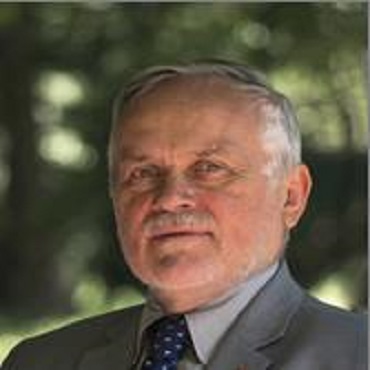Scientific Program
Keynote Session:
Title: Self-immolative versatile fluorogenic probes for hydrolase assays
Biography:
Prof. Ryszard Ostaszewski was graduated from the Warsaw Technical University in 1985. Since then he has been employed at the Institute of Organic Chemistry, Polish Academy of Sciences, where he obtained his academic degrees (Ph.D. in 1989 under the supervision of Professor Janusz Jurczak, D.Sc. in 1999, and professorship in 2009). He spent his postdoctoral stay at the University of Twente, The Netherlands (1989–1990) and at the University of Zurich, Switzerland, (1994-1995). From 2009 he holds a position of Full Professor at the Institute Of Organic Chemistry PAS. He has published more than 110 papers in reputed journals.
Abstract:
Enzyme-activated fluorogenic probes, which visualise enzymatic catalysis to trigger the generation of fluorescence, provide a versatile platform for monitoring biological processes in living cells and in vivo. Early enzyme-activated probes for hydrolase activity assays were primary based on p-nitrophenol esters derivatives. Although those esters are easily available and applicable low fluorescence of p-nitrophenol releasing during biochemical reactions limits application. Another problem is associated with reversibility of hydrolysis reaction. To overcome those problems a mixed carbonates were proposed for enzymatic assays. Our fist experiments have shoved positive evaluation of mixed carbonates of 4-methyl-7-hydroxycoumarin and various alcohols as a new class of fluorogenic compounds for detecting hydrolytic activities of enzymes.[1] Subsequent studies devoted to enantioselective hydrolase preference assays led to discovery of mixed carbonates of chiral alcohols and 4-methyl and 4-trifluoromethyl coumarins as an efficient tools for screening lipase and esterase enantiopreference.[2] In order to expand the spectrum of enzymes applicable for assays a new type of novel self-immolative probes for enzymatic screening was developed.[3] This system allowed enzymatic screening through a cascade reaction triggered by enzymatic cleavage. The synthesized probes were stable under aqueous conditions and not susceptible to nonspecific reactions. Due to the presence of a carbamate bond, the synthesized compounds are applicable for screening the activity of a wide range of hydrolases, such as lipases, esterases and proteases.
In the lecture the general concept devoted to self-immolative fluorogenic probes for detection of hydrolase assays will be presented and discussed on selected examples.
Title: Proteomics on the way to reverse Avogadro number
Biography:
Professor, Scientific Advisor of Institute of Biomedical Chemistry,
Was born January 10, 1940, in Kashin, Kalinin (Tver) region – scientist, biochemist. A.I. Archakov had organized a scientific school to study molecular organization and functioning of oxygenase cytochrome P450-containing systems, molecular mechanisms of the structure and function of membranes and biological oxidation. Under the guidance of A. I. Archakov, the institute’s members have developed a fundamentally new pharmaceutical composition “Phosphogliv” with antiviral activity for the treatment of liver diseases of various etiology. A.I. Archakov’s present-day/current areas of expertise relate to research in the field of post-genomic technologies, nanobiotechnologies, proteomics and metabolomics. A.I. Archakov is the pioneer in the development of proteomics in Russia. Currently, he is the international “Human proteome” project coordinator in Russia/ the coordinator representing Russia in the international “HP” project (http://www.proteom.ru).
Awards and Orders:
Bach Award (1982)
USSR State Prize (1983)
State Prize of the RSFSR (1989)
State Prize of the Russian Federation (1998)
Russian Government Prize in Science and Technology (2003)
The Order “For merit to the Fatherland” IV Degree (2000)
The Order “For merit to the Fatherland” III Degree (2007)
The Order “For merit to the Fatherland” II Degree (2016)
Abstract:
The main advances major challenges of the C-HPP – insufficient analytical sensitivity of proteomic technologies and the complexity of the proteome. The increased analytical sensitivity of proteomic technologies and the combined results from transcriptomic and proteomic analyses of a single chromosome of individual sample has facilitated the study of proteoforms. For example, of the 275 protein-coding genes on human chromosome 18, 85% of the transcripts were discovered using next-generation sequencing (NGS) and polymerase chain reaction (PCR), and 45% of the proteins were detected using shotgun and selected reaction monitoring technology, in both liver tissue and the HepG2 cell line. To increase proteome coverage, a combination of shotgun technology and selected reaction monitoring with two-dimensional alkaline fractionation has been recently developed by using UPS 1 and 2. Sigma Aldrige sets as the “gold standard”. To detect proteoforms that cannot be identified by such technologies, nanotechnologies such as combined atomic force microscopy with molecular fishing and/or nanowire detection were used. Both technologies provide a powerful tool for single molecule analysis, by analogy with nanopore sequencing during genome analysis. We believe that such approach could be used for detection of the «missing» proteins of the single chromosome during C-HPP. According our point of view the technology sensitivity drives the depth and width of proteome.
Title: Preclinical verification of the efficacy of targeting peptides linked liposomal nanoparticles for therapy of hepatocellular and nasopharyngeal carcinomas and breast cancer
Biography:
Dr. Chin-Tarng Lin, D.D.S., Ph.D., has devoted several decades to perform molecular pathological cancer research. He was a pathology professor and is an Emeritus professor right now at the College of Medicine, National Taiwan University. He has published more than 92 papers and obtained 12 patents and has been invited to give the scientific seminar over 75 times. He has presented 191 abstracts to attend the world wide biomedical science meetings. His research interests include the development of immunohistochemical localization of protein, mRNA and DNA molecules at the light and electron microscopic levels and peptide histochemistry to identify the peptide targeted binding protein. He has established 10 nasopharyngeal carcinoma cell lines (NPC-TW01to10) and five endometrioid cancer cell lines (OV-TW59-P0 to-P4) in his laboratory. His major interests are to investigate the molecular pathogenesis of NPC with or without Epstein-Barr virus infection and of ovarian cancer. He and his colleague have identified 3 specific peptides to localize their targeted proteins, to identify the cancer xenograft by MRI and to perform peptide-targeted chemotherapy for different cancers with a minimal adverse event.
Abstract:
The efficacy of systemic cytotoxic chemotherapy has been widely assessed in patients with advanced hepatocellular carcinoma (HCC). For example, doxorubicin is the most commonly studied chemotherapeutic agent for HCC. However, it has been shown to have a response rate of only 10-20% in clinical trial. In addition, its potential benefit has been reduced by the related adverse effect. So far, the multikinase inhibitor, sorafenib, is considered to provide survival benefit over supportive care. However, the long term prognosis of those cancer patients still remain poor. Therefore, in the present experiment, we proposed to use the so-called peptide targeting chemotherapy to overcome the adverse event in the conventional targeted chemotherapy. In order to perform this experiment, we have construct some specific peptides which can bind specifically to the cancer cells and cancer vascular endothelia by using a phage displayed 12-mer random peptide library. We have obtained 3 different peptides and one control peptide. Each contains 12 amino acids: a. L-peptide: RLLDTNRPLLPY (anti-different cancer cell membrane); b. control peptide: RLLDTNRGGGGG; c. SP-94-peptide: SFSHHTPILP (anti-NPC tumor cell and hepatoma cell membranes) and d. PC5-52-peptide: SVSVGMKPSPRP (anti-tumor endothelia). Those L-peptide (L-P), SP-peptide (SP-P), PC5-52-peptide and a control peptide (C-P) were linked to liposomal iron oxide nanoparticles; and also used those peptides to link liposomal doxorubicin (L-D). Using peptide linked liposomal iron oxide, we can localize the peptide targeted tumor cells and tumor endothelia, and then we used those peptides linked liposomal doxorubicin to treat SCID mice bearing different cancer xenografts. Our results showed that when L-P-L-D containing 2mg/kg of SCID mouse body weight was used to treat xenografts bearing SCID mice, the tumor could be well controlled, and no specific adverse event was seen. However, when the control peptide was used to replace the specific peptide, the xenograft size was also shown decrease, but the visceral organs revealed marked apoptotic change. In conclusion, the specific peptides linked liposomal doxorubicin nanoparticles can be used for treatment of SCID mice bearing cancer xenografts with minimal adverse event, especially in the SCID mice species (NGS), which show remarkable tumor suppression.
Title: Microbiota dysbiosis is associated with HPVâ€induced cervical carcinogenesis
Biography:
Wojciech Kwasniewski completed his PhD in 2012 the age of 27 years from Medical University of Lublin, Poland. In 2019 he obtained the title of specialist in the field of gynecology and obstetrics and received the title of habilitated doctor. He works at the Department of Oncological Gynecology SPSK 1 in Lublin as an assistant professor.
Abstract:
Cervical microbial communities serve a crucial role in the persistence and development of oncogenic human papilloma virus (HPV) infections. In the present study, the authors hypothesised that disturbed heterogeneity of microbial flora was associated with HPVâ€induced carcino- genesis. Swabs of the cervical microbiota were collected from 250 women and the 16S ribosomal DNA was sequenced using a high throughput assay. The swabs of cervical micro- biota were grouped according to the community state types (CSTs) as follows: Healthy cervical swabs; swabs taken from lowâ€grade squamous intraâ€epithelial lesions (LSIL) and swabs taken from highâ€grade squamous intraâ€epithelial lesions (HSIL). Analysis of the bacterial classes revealed that the CST cervical swabs of the volunteers were charac- terised by Lactobacillus crispatus, Lactobacillus iners and Lactobacillus taiwanensis, however, Gardnerella vaginalis and Lactobacillus acidophilus were absent. In the CST of patients with LSIL the predominant type of bacteria was Lactobacillus acidophilus and Lactobacillus iners, however Lactobacillus crispatus was not detected. Swabs from CST women diagnosed with HSIL exhibited abundant Gardnerella vaginalis and Lactobacillus acidophilus, however, lacked Lactobacillus taiwanensis, Lactobacillus iners and Lactobacillus crispatus. The abundance of Lactobacillus acidophilus in swabs from the healthy women was compared with the swabs from the women with LSIL. The results of the present study indicated that the development of HPVâ€induced cancer is associated with a high diversity of vaginal microbiota, which is involved in the control of viral persistence, and is therefore indicative of disease prognosis.
Title: A new insight on beech bud extract and skin enzymatic desquamation
Biography:
Chloe Clabault has completed her PharmD at the age of 25 years from Paris Descartes University and Masters in Cosmetology, Paris Sud University, France.
She is in charge of Scientific Valorization for Lancome Skincare Laboratories.
Abstract:
Epidermis is the most superficial tissue of the skin that plays a vital role as an effective barrier between internal and external environments [1]. This tissue is in a continuous renewal due to highly organized process of cell proliferation, differentiation, cornification and desquamation. Desquamation is linked to a loss of cohesion between superficial dead cells, the corneocytes. This cohesion is provided by specific cell junctions named corneodesmosomes where their enzymatic degradation leads to desquamation. Up to now, all these enzymatic mechanisms remain not completely understood [2]. Despite, it seems clear that the absence (or mutation) of any of these enzymes might induce epidermal barrier disruption [3].
Beech bud extract has been shown boosting cell metabolism and hydrating the skin. The present study aimed: i) at evaluating the ability of this sustainably sourced cosmetic ingredient to modulate the epidermal desquamation and ii) at understanding its effect on enzymes linked to this process.
We have shown that, when applied topically on ex-vivo skin explants, the beech bud extract significantly reduces the cohesion between the epidermal most superficial cell layers. When applied onto keratinocytes cell cultures, the beech bud extract increased the gene expression of three enzymes (KLK5, KLK 7, CTSL 2) that are directly involved in the desquamation process [2,4].
Moreover, we have shown that the beech bud extract induces a significant decrease of stratum corneum cohesion, similar to glycolic acid 30% that was used as a reference, which confirms its pro-desquamation activity.
Taken together, these results suggest that the beech bud extract might promote the desquamation through the increase of desquamation enzymes gene expression. Accordingly, this beech bud extract appears as a valuable cosmetic ingredient towards skin revitalization and refinement of skin texture.
Title: Glucose-6-Phosphate Dehydrogenase Deficiency among neonates with hyperbilirubinemia in a tertiary care hospital in the north eastern region of India
Biography:
Ngangom Arunkumar Singh has completed his MD (Biochemistry) in 2008 from Regional Institute of Medical Sciences, Imphal, and Manipur, India. He is at present working as Assistant Professor in the Department of Biochemistry, Regional Institute of Medical Sciences, and Imphal. He has published more than 16 publications.
Abstract:
Glucose-6-Phosphate Dehydrogenase (G6PD) deficiency can lead to haemolysis due to impairment in the production of reduced glutathione. G6PD deficiency is the commonest enzyme deficiency in human affecting about 400 million people worldwide. In the neonates G6PD deficiency can lead to hyperbilirubinemia which can ultimately progress to the more serious condition of kernicterus if not diagnosed and treated in time. High prevalence of G6PD deficiency with an overall prevalence of 7.7% is reported among the tribal population of India which are also malaria endemic area. The study was designed to estimate prevalence of G6PD deficiency among neonates with hyperbilirubinemia in a tertiary care hospital in the north eastern region of India which is predominantly a tribal populated area with high malarial endemicity
Material and Methods:
A prospective study was designed at Regional Institute of Medical Sciences Hospital, Imphal among 150 newborn with neonatal hyperbilirubinemia who were screened for any G6PD deficiency and other causes. Participants were enrolled from Nov. 2012 to October 2014. The neonates were followed up to see if they required any phototherapy and exchange transfusion.
Results:
Among the 150 neonates with hyperbilirubinemia, 18(12%) were G6PD deficient and out of the 18 G6PD deficient neonates 9 (50%) required phototherapy while 3 (16.6%) required exchange transfusion. It was also observed that G6PD deficiency was the commonest cause of pathological neonatal hyperbilirubinemia when compared to other causes
Conclusion:
There is a high prevalence of G6PD deficiency among neonates with hyperbilirubinemia and screening for G6PD deficiency among such new born can prevent further complication. The screening for G6PD deficiency seems more relevant for a region like North Eastern India which is a malaria endemic area.
Title: Biochemical characterization of gamma-glutamyl transferase from Bacillus altitudinus: A potential enzyme for L-theanine production
Biography:
Abstract:
L-theanine (L-Th), a non-protein amino acid present in tea is a valuable nutraceutical and food additive, amongst the top best seller for insomnia and generally regarded as safe (GRAS) ingredient by Food and Drug Administration (FDA). In vitro, in vivo as well as clinical studies have shown its positive effect in regulating various neurological disorders. L-Th enhances umami taste in tea and other foods but its use is limited due to its inadequate production in tea plant (7-21 mg/g dry weight basis). Amongst the different reported production and extraction approaches, microbial transformation with advantages like highest possible efficiency, least waste formation and lowest environmental impact have been tried to meet its demand. More than 300 isolates from tea rhizosphere were screened for L-theanine synthesis using glutamine (20 mmol L-1) and ethylamine (50 mmol L-1) as donor and acceptor, respectively. Highest L-theanine producing strain was identified as Bacillus altitudinus through physiological and biochemical properties with 16 S rRNA sequence analysis and was further taken for optimization studies. The production of extracellular enzyme γ-Glutamyl transferase (GGT) was optimized using one-variable-at-a-time (OVAT) and statistical approaches i.e., Plakett-Burman and Central Composite Design. Maximum GGT production of 442 U ml-1 was obtained at 28 ËšC, 200 rpm and pH 7 with glucose (0.1%) and yeast extract (0.3%) as carbon and nitrogen sources. GGT was purified to homogeneity from culture of Bacillus altitudinus in three steps and characterized. A molecular mass of 62 kDa was determined by gel filtration chromatography. The purified GGT has optimum pH and temperature 8.0 at 37 ËšC, stable up to pH 6-10 and temperature < 50 ËšC. The enzyme exhibited the highest affinity for Ca2+ ions. GGT produced from Bacillus altitudinus represents an attractive candidate for large scale L-Th production.
Title: Crude plant extracts: Potential bio-fertilizers and treatment against tomato plant infection
Biography:
Peter Mudiaga Etaware has completed his Ph.D. at the age of 38 years from the University of Ibadan, Ibadan, Nigeria (Awaiting postdoctoral appointments in Plant Pathology and Microbiology). He is a seasoned researcher with penchant for excellence. He developed “ETAPOD” the first forecast model in Nigeria to predict black pod disease outbreak using simple analytical software. He was honoured with the prestigious award of the “University Scholar, 2004/2005”. He is the CEO of Rex-Lab, a premier data analytical company. He has published more than 10 research articles in reputed journals and he is an editorial board member of repute.
Abstract:
L-theanine (L-Th), a non-protein amino acid present in tea is a valuable nutraceutical and food additive, amongst the top best seller for insomnia and generally regarded as safe (GRAS) ingredient by Food and Drug Administration (FDA). In vitro, in vivo as well as clinical studies have shown its positive effect in regulating various neurological disorders. L-Th enhances umami taste in tea and other foods but its use is limited due to its inadequate production in tea plant (7-21 mg/g dry weight basis). Amongst the different reported production and extraction approaches, microbial transformation with advantages like highest possible efficiency, least waste formation and lowest environmental impact have been tried to meet its demand. More than 300 isolates from tea rhizosphere were screened for L-theanine synthesis using glutamine (20 mmol L-1) and ethylamine (50 mmol L-1) as donor and acceptor, respectively. Highest L-theanine producing strain was identified as Bacillus altitudinus through physiological and biochemical properties with 16 S rRNA sequence analysis and was further taken for optimization studies. The production of extracellular enzyme γ-Glutamyl transferase (GGT) was optimized using one-variable-at-a-time (OVAT) and statistical approaches i.e., Plakett-Burman and Central Composite Design. Maximum GGT production of 442 U ml-1 was obtained at 28 ËšC, 200 rpm and pH 7 with glucose (0.1%) and yeast extract (0.3%) as carbon and nitrogen sources. GGT was purified to homogeneity from culture of Bacillus altitudinus in three steps and characterized. A molecular mass of 62 kDa was determined by gel filtration chromatography. The purified GGT has optimum pH and temperature 8.0 at 37 ËšC, stable up to pH 6-10 and temperature < 50 ËšC. The enzyme exhibited the highest affinity for Ca2+ ions. GGT produced from Bacillus altitudinus represents an attractive candidate for large scale L-Th production.
Title: KLF15 Regulates Endobiotic and Xenobiotic Metabolism (Video Presentataion)
Biography:
Abstract:
Hepatic metabolism and elimination of endobiotics (e.g., steroids, bile acids) and xenobiotics (e.g., drugs, toxins) is essential for health. While the enzymatic (termed phase I-II) and transport machinery (termed phase III) controlling endobiotic and xenobiotic metabolism (EXM) is known, our understanding of molecular nodal points that coordinate EXM function in physiology and disease remains incompletely understood. Here we show that the transcription factor Kruppel-like factor 15 (KLF15) regulates all three phases of the EXM system by direct and indirect pathways. Unbiased transcriptomic analyses coupled with validation studies in cells, human tissues, and animals, support direct transcriptional control of the EXM machinery by KLF15. Liver-specific deficiency of KLF15 (Li-KO) results in altered expression of numerous phase I-III targets, and renders animals resistant to the pathologic effect of bile acid and acetaminophen toxicity. Furthermore, Li-KO mice demonstrate enhanced degradation and elimination of endogenous steroid hormones, such as testosterone and glucocorticoid, resulting in reduced male fertility and blood glucose level, respectively. Viral reconstitution of hepatic KLF15 expression in Li-KO mice reverses these phenotypes. Our observations identify a previously unappreciated transcriptional pathway regulating metabolism and elimination of endobiotics and xenobiotics.
Title: Structure and Function of -1,3-Glucanase from Streptomyces thermodiastaticus HF3-3
Biography:
Ph.D. student in biotechnology at Ritsumeikan University who has passion to innovate and to develop the new innovation and products by using microorganism. Research experiences include protein purification, production recombinant protein, protein crystallization, genetic engineering, isolation, screening, culture, and identification microorganisms.
Abstract:
a-1,3-glucan (mutan) is a water-insoluble, linear a-1,3-linked homopolymer of glucose, which is the main component of extracellular polysaccharide, was synthesized from sucrose by Streptococcus mutans via glycosyltransferases (GTFs) that are cause of dental plague in human. It has also been found in fungi as a component of cell wall, carbon source and virulent factor of pathogenic fungi. Considering from this background, we have interested in studying a-1,3-glucanase (mutanase) that can hydrolyze a-1,3-glycosidic bond of a-1,3-glucan. In the previous study was determined the amino acid sequence of GH 87 a-1,3-glucanase from Streptomyces thermodiastaticus HF3-3 (Agl-ST2) which was categorized as a new group of a-1,3-glucanase, multi-domains enzyme including N-terminal binding domain, carbohydrate binding module family 35 (CBM35), C-terminal catalytic domain and discoidin domain (DS), respectively. The comparison of Agl-ST2 with the related enzymes revealed high similarity to mycodextranase (85%), whereas had low homology with the known a-1,3-glucanase. But the properties indicated that Agl-ST2 belongs to a-1,3-glucanase. Since Agl-ST1 is generated from Agl-ST2 by truncation of DS region, Agl-ST1 has the same multi-domain as Agl-ST2 but without DS. In this study to understand domain structure and function of Agl-ST (1&2), we determined each domain structure and function of the Agl-STs in the a-1,3-glucan binding and hydrolysis by constructing several domain deletions and site-directed mutation in catalytic domain. The results showed that Agl-ST with site-directed mutation at the critical amino residues had little activities of hydrolysis a-1,3-glucan, while the enzymes lacking catalytic domain lower binding activities than the wild type .
Title: Efficient synthesis of L-theanine in recombinant Escherichia coli containing γ-Glutamyltranspeptidase gene from Pseudomonas nitroreducens (PnGGT)
Biography:
PHUMSOMBAT Putthapong is currently Ph.D. student at Ritsumeikan University, supported by Japan under JICA innovative Asia scholarship. He received both Bachelor and Master degree from Kasetsart University, Thailand before continue his research at enzyme technology laboratory, under the guidance of Prof. MAMORU Wakayama. He is working on project of improving enzyme activity of recombinant GGT. His field of interest is enzymology, biotechnology, molecular genetics, protein technology and lactic acid bacteria.
Abstract:
L-Theanine (γ-glutamylethylamide) is a non-protein amino acid present in tea. It contributes to the umami taste and unique flavor to green tea infusion. It was reported to have many beneficial physiological effect, especially anti-stress and improvement of concentration for learning ability. It can be obtained by chemical synthesis or extraction from green tea, but both processes involve time consuming, cost-ineffective and complicated operational process. Hence, biotechnological production of L-theanine become interesting by using microbial enzyme such as glutamyltranspeptidase (GGT). GGT (EC 2.3.2.2), a heterodimeric enzyme found in various sources from bacteria to mammals catalyzes the transfer of the γ-glutamyl moiety of γ-glutamyl compound to γ-glutamyl acceptors such as amino acids and peptides. Bacterial GGTs have been reported in Escherichia coli (EcGGT), Bacillus licheniformis (BlGGT), and Pseudomonas nitroreducens (PnGGT). Our previous study on site directed mutagenesis of PnGGT suggested that Trp525 was a key amino acid residue in determining the preference of acceptor substrate in the reaction. Moreover, E. coli producing W525D mutant of PnGGT (E. coli-W525D mutant) showed low hydrolysis activity with high transfer activity, causing the increase of L-theanine production from ethylamine and L-glutamine. Improving the efficiency of L-theanine production using E. coli -W525D mutant was also achieved by whole cell calcium-alginate immobilization with determination of optimal pH, temperature, and molar substrate ratio. Under the suitable condition, pH 11, 40ºC, and substrate molar ratio of 1:10, L-glutamine: ethylamine, E. coli W525D mutant exhibited the highest theanine production compared to P. nitroreducens, E. coli-wild type, and other recombinant mutant strains.












